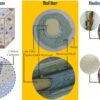A recent study published in JCI found that a neutrophil’s endoplasmic reticulum, the organelle that normally makes proteins in the cell, becomes stressed in the autoimmune disorder lupus. This stress activates a molecule called IRE1α, which appears to play a critical role in lupus pathogenesis in mice.
A multidisciplinary research group at the University of Michigan, spanning microbiology, dermatology and rheumatology, discovered that IRE1α orchestrates the release of neutrophil extracellular traps, or NETs, from lupus neutrophils. NETs are sticky, spider web-like structures that cause inflammation when released at the wrong time or in the wrong place.
NETs play an important role in the pathogenesis of lupus and other autoimmune diseases, where they trigger autoantibody formation and contribute to blood vessel clotting and damage.
Thanks to the previous work of study authors Basel Abuaita, Ph.D. and Mary X. O’Riordan, Ph.D., microbiologists and immunologists at Michigan Medicine, the research group knew that the IRE1α pathway was important for neutrophil activation in models of another potentially deadly disease, Staphylococcus aureus infection.
“Given that neutrophils are over-activated in lupus, we hypothesized that the IRE1α pathway might be part of the story in this disease, too,” says Gautam Sule, Ph.D., a postdoctoral fellow in rheumatology at Michigan Medicine. “It’s what prompted this collaboration, and the result was the discovery of an abnormally activated IRE1α pathway in lupus patient neutrophils, which tracks closely with disease severity.”
However, this new study posed unique challenges, because according to study author Jason S. Knight, M.D., Ph.D., a rheumatologist at Michigan Medicine, neutrophils aren’t easy to study.
“Although neutrophils are the most common white blood cells in circulation, they’re hard to work with in the laboratory because they don’t live long and there isn’t a good cell line system to replicate their functions,” he says.
This meant the research team had to purify neutrophils from human blood on a daily basis for their experiments but, luckily, the work paid off.
While the team now understands more about neutrophil biology in lupus, they say there’s still more digging to do and the next steps will include an analysis of a larger group of patients with lupus, and likely other related diseases such as antiphospholipid syndrome.
“This was a great partnership of basic cell biologists and translational scientists. This project wouldn’t have been possible if either one of our groups had tried to go at it alone,” says Knight. “We’re lucky to be at a place like U-M where these partnerships are not only possible but actively encouraged.”
New research finds ginger counters certain autoimmune diseases in mice
More information:
Gautam Sule et al, Endoplasmic reticulum stress sensor IRE1α propels neutrophil hyperactivity in lupus, Journal of Clinical Investigation (2021). DOI: 10.1172/JCI137866
Provided by
University of Michigan
Citation:
Research group identifies potential therapeutic target for lupus (2021, March 26)
retrieved 27 March 2021
from https://medicalxpress.com/news/2021-03-group-potential-therapeutic-lupus.html
This document is subject to copyright. Apart from any fair dealing for the purpose of private study or research, no
part may be reproduced without the written permission. The content is provided for information purposes only.



